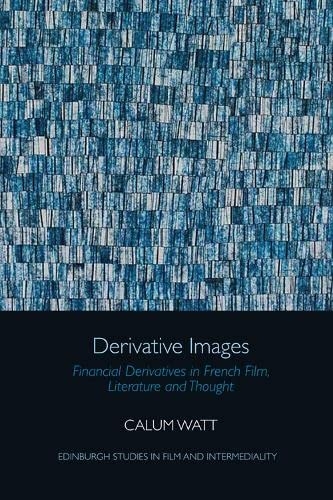Derivative Images: Financial Derivatives in French Film, Literature and Thought by Calum Watt

CHAPTER ONE
Lordon and the 2008 Crisis
D’un retournement l’autre
At the end of August 2008, just weeks before the collapse of the US investment
bank Lehman Brothers on 15 September, which was the most acute
moment of the crisis, provoking real fears that the entire global banking system
was on the brink of collapse, the philosopher and economist Frédéric
Lordon was finishing the manuscript of Jusqu’à quand? Pour en finir avec les
crises financières (‘For How Much Longer? Let’s Finish With Financial Crises’).
This text should be read alongside his satirical play about the crisis, D’un
retournement l’autre: Comédie sérieuse sur la crise financière. En quatre actes, et
en alexandrins (‘From One Turnaround to Another: Serious Comedy about
the Financial Crisis’, 2011). Explaining the financial turmoil, Lordon refers
to autumn 2007 as ‘le grand retournement’ (‘the great reversal’).
Referring
to the closure of investment funds at Bear Stearns on 22 June 2007 as a key
point in the brewing crisis, but also events in France, such as the closure of
funds by the management company Oddo on 26 July 2007, Lordon remarks
with typical wit: ‘On y voit, comme à l’endoscopie, l’intérieur de la machine
en train de convulser’ (‘Here we see, as in an endoscopy, the convulsions
inside the machine’).
However, more serious alarm was sounded on 9 August
2007, when funds were frozen at France’s biggest bank, and the second
biggest bank in the eurozone, BNP Paribas.
For Marc Roche, a former journalist at Le Monde, this should be taken as
the real start date of the crisis.
At
7 a.m. the bank published a laconic communiqué announcing the freeze:
La disparition de toute transaction sur certains segments du marché de la
titrisation aux Etats-Unis conduit à une absence de prix de référence et à
une illiquidité quasi-totale des actifs figurant dans les portefeuilles des fonds
quelle que soit leur qualité ou leur rating. Cette situation ne permet plus
d’établir une juste valorisation des actifs sous-jacents et donc de calculer une
valeur liquidative pour ces 3 fonds.
[The complete evaporation of liquidity in certain market segments of the
US securitisation market has made it impossible to value certain assets fairly
regardless of their quality or credit rating. The situation is such that it is
no longer possible to value fairly the underlying US ABS assets in the three
above-mentioned funds.]
The word jumped on by the financial press, Roche notes, was liquidity: the
ready availability of funds. If an institution lacks liquidity, it may not be able
to make payments, even though it may be solvent. In other words, it was
impossible to calculate the value of the funds that had been invested in subprimes.
Unable to value their assets, this limited the ability of already highly
over-leveraged banks to borrow. This cast in doubt the state of not just BNP
Paribas, but of Europe’s banks in general.7
All major French banks suffered
that day losses of between 3 and 6 per cent.8
The leaders at BNP were perplexed that such an apparently insignificant
action had set off concern. The
director general Baudouin Prot had only a week earlier given assurances about
its liquidity, saying that it had not been affected by the growing concerns
about subprimes, ‘grâce à sa politique de risque prudente’ (‘thanks to its prudent risk policy’).
The European Central Bank under Jean-Claude Trichet,
like the Federal Reserve in the USA, was at this point lending large sums to
refinance the banks. Adam Tooze agrees that this was ‘the really decisive
break in market confidence [. . .] the equivalent of a giant bank run’. It was
only a few weeks later that the British bank Northern Rock would fail. This
date is alluded to rather elliptically in D’un retournement l’autre, when the
fourth banker says to the third, implying he is a BNP Paribas banker: ‘Vous
avez eu, dit-on, des craintes assez fortes, / Pour que trois de vos fonds mettent
clé sous la porte’ (‘It is said you must have had serious concerns / To close
three of your funds’).
Lordon is a prominent public intellectual who makes regular appearances
in the French media, was a key figure in the Nuit debout movement of 2016
and is active in support of the gilets jaunes and various other protest movements.
He also comments on political and economic developments on his
blog and in Le Monde diplomatique.
His play is loosely based on the Sarkozy
government’s reaction to the financial crash and shows the interaction between
a group of bankers and the office of the president as the crisis unfolds. The
play gave rise to several stage productions and was filmed by the prolific leftwing
director and writer Gérard Mordillat as Le Grand Retournement (‘The
Great Reversal’, 2013). In this chapter I briefly outline the conceptual aims
of the play, situating it in respect of Lordon’s more recent activism before
asking critically how effective Lordon’s play – and the concepts of image and
affect through which he theorises it – are in a time of crisis.
Lordon’s play opens with a group of bankers discovering their exposure
to the subprime mortgage crisis: the property market is collapsing, everyone
is up to their neck in debt and nobody can pay. The new financial
products, it is said, are so complex that no one understands how they work.
It is decided that they will collude with journalists and blackmail the state
to save themselves.
Derivative Images: Financial Derivatives in French Film, Literature and Thought by Calum Watt




